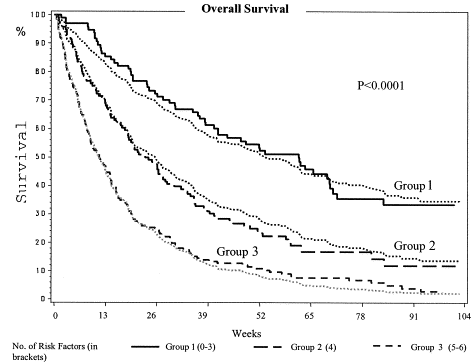A predictive model
for survival in metastatic cancer patients attending an outpatient palliative radiotherapy
clinic
IJROBP:Volume 53, Issue 5, Pages 1291-1302 (1 August 2002)
Purpose: To develop a predictive model for survival from the time of presentation in an
outpatient palliative radiotherapy clinic.
Methods and Materials: Sixteen factors were analyzed prospectively in 395 patients seen in
a dedicated palliative radiotherapy clinic in a large tertiary cancer center using
Cox’s proportional hazards regression model.
The severity of the nine symptoms (covariates 8–16) assessed by the modified ESAS was
classified as none (0), mild (1–3), moderate (4–7), and severe (8–10).Number of risk factors method
The patients were also grouped according to the total number of risk factors that they
possessed. The six risk factors are as follows: (1)
non-breast cancer patients, (2) sites of metastases other than bone only, (3) KPS <60,
(4) fatigue score moderate to severe, (5) appetite score severe, and (6) shortness of
breath score any.
Ninety-eight of 395 (25%) patients with 3 or less risk factors were classified in Group 1,
117 (30%) patients with 4 risk factors were assigned to Group 2, and 180 (46%) patients
with 5 to 6 risk factors were assigned to Group 3. This grouping led to reasonable
separation of survival curves, with a fairly good fit between the model and the actual
Kaplan-Meier survival curves.
Values of median survival and 95% confidence intervals for
each group were as follows: Group 1 = 62 weeks (41–70 weeks),
Group 2 = 24 weeks (18–29 weeks), and Group 3 = 11 weeks (9–14 weeks) (p <
0.0001). |
